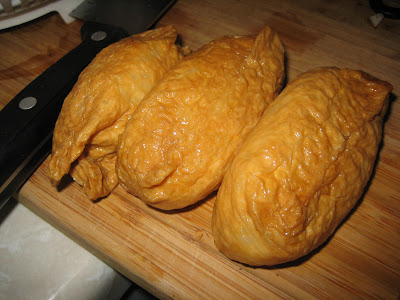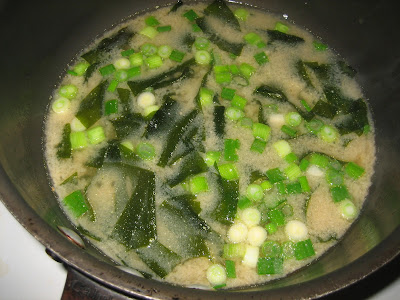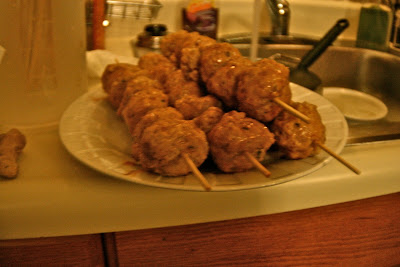"Across the skies, five continents, and seven seas, in the middle of this earth, there is a school for witchcraft and wizardry. It is said that long ago, in ancient times, this school was created by the power of the floating rock and the flying rock, a power wielded by the two wizards who survived the last battle. This was written in the prophetic book of preemergence and preexistence: The school is honored by the gods for nurturing new generations of witches and wizard. Surrounded by four elemental spirits - fire, water, wind, and earth - and under the protection of the light spirit, this academy has endured on this mother earth for many centuries..."
Gyoza
(Pork Dumplings)
10 oz ground pork or chicken
7 oz raw peeled shrimp (I just went for the pure pork)
1/2 cup shredded Chinese Cabbage
2 spring onions sliced
2 tsp ginger, grated
1 egg, lightly beaten
2 tsp soy sauce
1 tsp mirin
1 tsp sake
30 gyoza wrappers, or as many as are needed to use up all the filling
2 tbsp vegetable oil for frying
For the Dipping Sauce
3 tbsp soy sauce
3 tbsp rice vinegar
1 1/2 tbsp sesame oil
1 1/2 tsp sugar
pinch or more of chili flakes (as spicy as you want it)
Mix all the filling ingredients from the pork through the sake.
They should be thoroughly mixed.
Cooking with Dog goes so far as to suggest that you should even knead the mixture in order to get a more chewy consistency.
They should be thoroughly mixed.
Cooking with Dog goes so far as to suggest that you should even knead the mixture in order to get a more chewy consistency.
Making sure that you are only taking one thin wrapper at a time (they stick!), fill the center of the wrapper with about a tablespoon of the pork mixture (overfilling will damage the structural integrity of your dumpling and threaten sticking to the pan, but more on that later). As far as sealing the gyoza wrappers, you're more or less on your own. If you aren't adept at it, as 2 of my Alabama kitchen helpers were, thank you Jay and Obe (Jay's were nicer looking...), I would avoid trying to make the fancy pleats and either take Ben's approach, which was just to wet the edges of the wrapper with water and press them together in an unpleated half-moon, or the cheater's approach, the dumpling molds. I completely forgot that I even had them leftover from my Russian pierogi making days.
Once the wrappers are all filled, you want heat the oil in a large frying pan, and add enough gyoza to cover the bottom of the pan.
Cook until the bases are crisp and golden, then add 1/2 cup of water, cover and cook for 5 minutes, or until all the water has evaporated.
Mix the dipping sauce ingredients together and serve immediately with the hot gyoza.
Cook until the bases are crisp and golden, then add 1/2 cup of water, cover and cook for 5 minutes, or until all the water has evaporated.
Mix the dipping sauce ingredients together and serve immediately with the hot gyoza.
Or, instead of serving immediately, you could waste a bunch of time prying the gyoza off the bottom of the pan where they have stuck with a vengeance. You could also try your second batch without the oil first, thinking that might have been the problem, and then pry those off as well. You could further, though I don't recommend it, take the uncooked dumplings home and try to cook them the next day in a heavier bottomed skillet that holds the heat more evenly, but by then they will have sat together, soaking up the moisture from the filling. They will be sticky, impossible to separate and even more difficult to cook without losing the best part, their crisply fried outer skins.
Despite the many mishaps, all the dumplings were eaten to rave reviews. I think it was the extra pinch of chili flakes in the dipping sauce that made them so delicious. I might also suggest adding a little salt to the pork mixture, for some added flavor, or possibly just increasing the soy sauce a bit.
I am at a point in my cooking where I have to decide whether I want to put the effort, and possible tears, into trying to master this dish, or whether I want to concede and put it on the list with fried chicken - cheap enough to pay somebody else to do a better job. I will keep you posted.
Ankake Udon
(Udon Noodles with Egg Broth and Ginger)
14 oz dried udon noodles
4 eggs, beaten
2 spring onions, finely chopped
1 inch ginger, grated
For the soup
4 cups of dashi stock
1 1/2 tbsp each mirin, sake, soy sauce
1 1/2 tsp salt
2 tbsp cornstarch
Cook the udon noodles according to the package directions. Heat the soup stock to boiling. Blend the cornstarch with 4 tbsp of water, reduce the heat to medium, and blend the starch into the stock. The soup will thicken after a few minutes, then reduce the heat to low.
Mix the egg, greens, and onions together in a small bowl.
Create a whirlpool in the stock and slowly pour in the egg mixture. Divide the udon noodles into 4 bowls and pour the soup over the top. Sprinkle 1/4 of the ginger into each bowl. Serve hot.
Do not cut your finger so deeply that you start to feel faint while chopping mustard greens. It throws off all your concentration, and you will probably forget to add the cornstarch to the soup. Thankfully, there was no red in my greens and after a quick rest and emergency bandaging by Jay, the soup turned out to be a good restorative, regardless of its unthickened broth. I loved it. A nice vegetarian meal for the asking.
We also partook of some delicious hot sake:
About the book:
Can you say Harry Potter in a Japanese hat? I haven't read any more than that yet, but sheesh, some originality would be great.
Mix the egg, greens, and onions together in a small bowl.
Create a whirlpool in the stock and slowly pour in the egg mixture. Divide the udon noodles into 4 bowls and pour the soup over the top. Sprinkle 1/4 of the ginger into each bowl. Serve hot.
Do not cut your finger so deeply that you start to feel faint while chopping mustard greens. It throws off all your concentration, and you will probably forget to add the cornstarch to the soup. Thankfully, there was no red in my greens and after a quick rest and emergency bandaging by Jay, the soup turned out to be a good restorative, regardless of its unthickened broth. I loved it. A nice vegetarian meal for the asking.
We also partook of some delicious hot sake:
About the book:
Can you say Harry Potter in a Japanese hat? I haven't read any more than that yet, but sheesh, some originality would be great.



















 B
B













